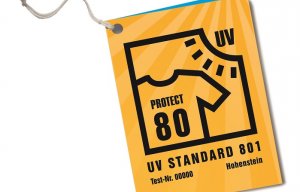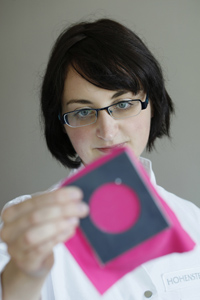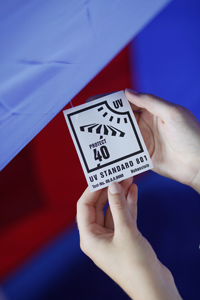
Understanding UV protective clothing
This summer, sun protection is literally a hot topic. Shading textiles such as sunshades, blinds and beach shelters promise to provide cooling shade and protection from harmful UV radiation and there is also more and more specific UV protection clothing to be found in the shops. But how in fact do textiles protect you from the sun's radiation, and what differences between them should be taken into account? Dr. Andreas Schmidt (AS) of the international Textile R

23rd August 2010
Innovation in Textiles
|
Bönnigheim
 This summer, sun protection is literally a hot topic. Shading textiles such as sunshades, blinds and beach shelters promise to provide cooling shade and protection from harmful UV radiation and there is also more and more specific UV protection clothing to be found in the shops.
This summer, sun protection is literally a hot topic. Shading textiles such as sunshades, blinds and beach shelters promise to provide cooling shade and protection from harmful UV radiation and there is also more and more specific UV protection clothing to be found in the shops.
But how in fact do textiles protect you from the sun's radiation, and what differences between them should be taken into account? Dr. Andreas Schmidt (AS) of the international Textile Research Centre at the Hohenstein Institute (HI) in Bönnigheim believes he has the facts and answers a number of important questions in this interview with the Hohenstein Institute’s press office:
(HI): Why do special UV protection textiles provide even better protection from the sun than cosmetic sun blockers with a high sun protection factor (SPF)?
(AS): The sun protection is, as it were, built into the processed chemical fibres. Titanium dioxide particles, such as are found in powders and sunscreen, are incorporated into the fibres and act like tiny mirrors there, reflecting the high-energy UV rays and so protecting the skin beneath. In addition, the UV protection in sun protection textiles is increased still further by special ways of constructing the fabrics, for example laying several layers on top of one another, covering the gaps between the fibres that inevitably occur in woven or knitted fabrics.
(HI): Which criteria determine the UV protection factor of textiles?
(AS): As well as the composition of the material, the way it is put together and the weight, the colour and surface finish of the materials also have an important effect on the UV protection factor (UPF) of a textile material.
(HI): What role does the colour of a textile material play in the UV protection factor?
(AS): Dark colours generally give better UV protection than pale colours, because the dye pigments also absorb UV radiation. This is why the Tuareg people in the Sahara have been dyeing their clothing dark blue for centuries. However, thanks to chemical treatments like UV absorbers, it is also possible nowadays to achieve similar results with lighter coloured fabrics.
(HI): Why do natural fibres only offer limited protection from UV radiation?
(AS): The UV protection given by natural fibres such as cotton or linen is relatively low. A white T-shirt has a UV protection factor of 10-15. The reason for this is that cotton fibres in themselves reflect or absorb little UV radiation. This is particularly true once they have become wet - the fibres then become almost see-through. Without this effect, there would be no such thing as wet T-shirt contests, for example (he laughs)! In addition, cotton fibres are kidney-shaped in diameter, i.e. within one fibre the diameter can be very variable. When this is combined with a twisted fibre structure, quite large holes appear in woven or knitted fabrics, through which the UV radiation can penetrate unhindered to the skin below.
(HI): Are there any natural fibres with a good UV protection factor?
(AS): Natural silk has a relatively high UV protection factor, because, like modern synthetic fibres, it contains matting components which reflect and absorb UV rays. The regular fibre structure, with small gaps in woven or knitted fabrics, also prevents the UV radiation from reaching the skin. Depending on the colour, the UPF may be 20 to 30. There is a good reason why in India, for example, silk sarongs are worn wrapped in several layers, which significantly increases the UV protection factor.
(HI): How is the UV protection factor of textiles indicated?
 (AS): The protection from UV radiation that textiles provide is indicated as a UV protection factor (UPF = Ultraviolet Protection Factor). This equates to the sun protection factor (SPF) for sun creams and indicates the factor by which the skin's own natural protection time – which depends on your individual skin type - is extended by the textile material. The skin of a person with skin type 1, for example, with red or blond hair, blue eyes and a very pale complexion, has a natural protection time of about five to ten minutes.
(AS): The protection from UV radiation that textiles provide is indicated as a UV protection factor (UPF = Ultraviolet Protection Factor). This equates to the sun protection factor (SPF) for sun creams and indicates the factor by which the skin's own natural protection time – which depends on your individual skin type - is extended by the textile material. The skin of a person with skin type 1, for example, with red or blond hair, blue eyes and a very pale complexion, has a natural protection time of about five to ten minutes.
If such a person is exposed to strong sunlight for any longer without protection, they risk dangerous sunburn. If they are protected by a textile material with UPF 80, they can extend the length of time they can remain in the sun by eighty times, without causing any skin damage. That is to say, to a maximum of 6.5 to 13 hours (80 X 5 min = 400 min to 80 X 10 min = 800 min). However, care must be taken to ensure that all parts of the body not covered by textiles are given additional protection with sun cream.
Instead of the UPF, the manufacturers of UV protection textiles often quote what percentage of the UV radiation is blocked by their products. How can consumers evaluate this information?
Such statements are hard for lay people to interpret. If, for example, 95% of the UV rays are blocked, that equates to a UPF of 20. So if you really want to be on the safe side when buying shading textiles, you should always ask detailed questions, have the information carefully explained to you and compare that with your personal requirements, which depend partly on your personal skin type and the resulting natural protection time (see chart).
(HI): You recommend that for both shading textiles and clothing the UPF is measured in accordance with UV Standard 801. Why is that?
(AS): The UV Standard 801 was developed in 1998 to overcome the weaknesses in the previous test standard called the Australian/New Zealand Standard (AS/NZ 4399:1996). This did not take account of the stresses and strains imposed during washing and regular use. By contrast, under the UV Standard 801, the UPF of a textile is determined not only when it is new, but also when it has been stretched and wetted, after mechanical strain and washing and after artificial weathering.
(HI): How many companies have their products tested using this test method?
(AS): There are now over 100 companies making a variety of products offering high UV protection who have them tested and/or certificated under UV Standard 801. On the UV Standard 801 website(www.uvstandard801.de ), you can see a selection of companies which endorse their products using UV Standard 801.
(HI): What kind of products are mainly assessed under UV Standard 801?
(AS): We recommend the measuring procedure under UV Standard 801 because it produces highly practical results for shading textiles like sunshades, blinds and beach shelters and all kinds of clothing textiles. The range of products extends from swimwear and leisure and trekking clothes to the fabrics used for working clothes. The main focus is on swimwear and leisure clothing for toddlers and children, for whom protection from UV radiation is particularly important.

Business intelligence for the fibre, textiles and apparel industries: technologies, innovations, markets, investments, trade policy, sourcing, strategy...
Find out more